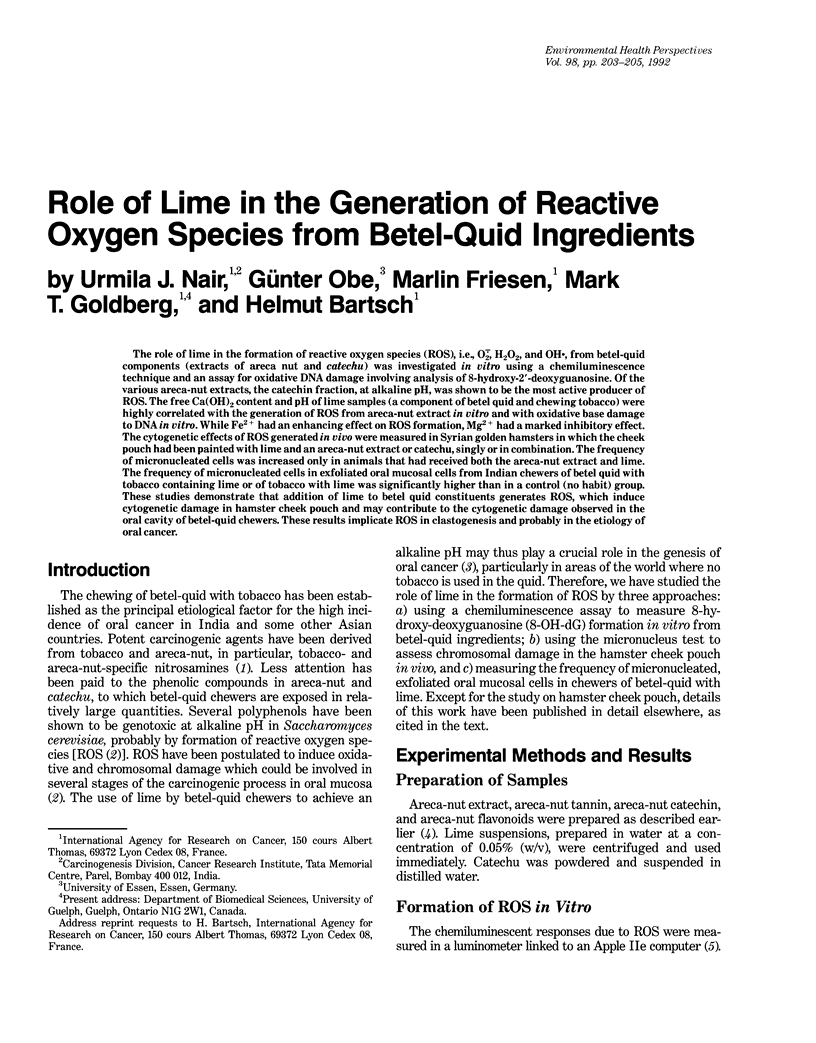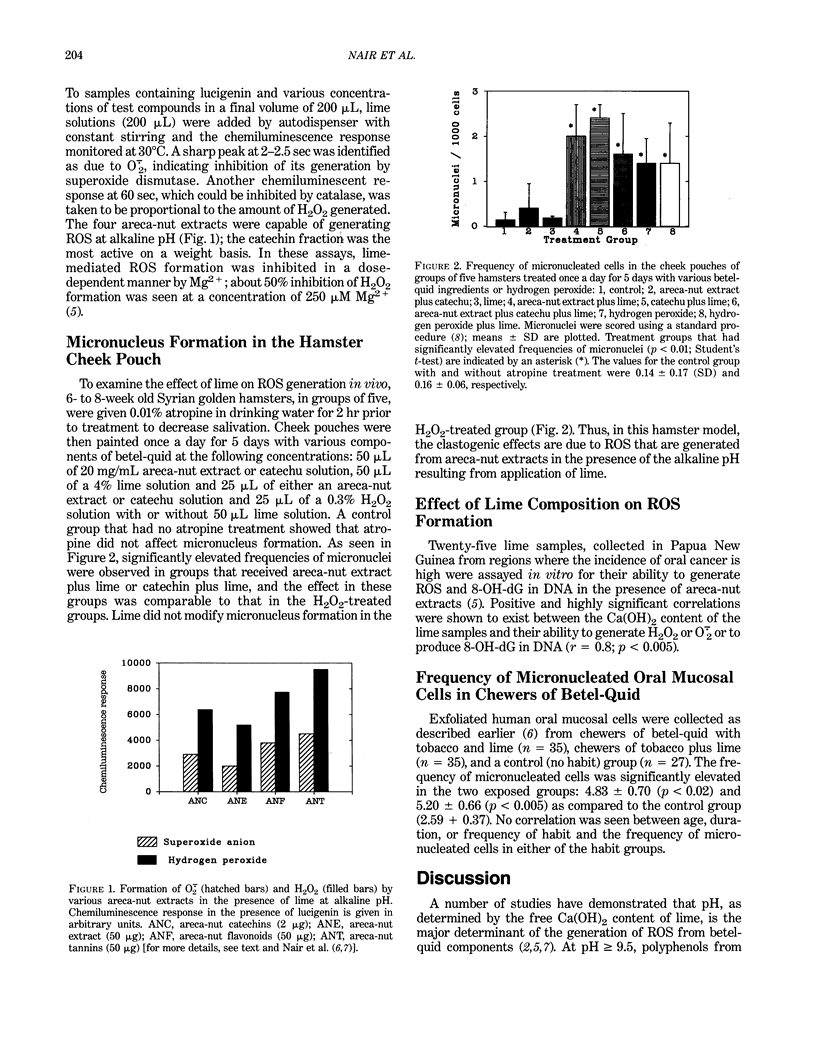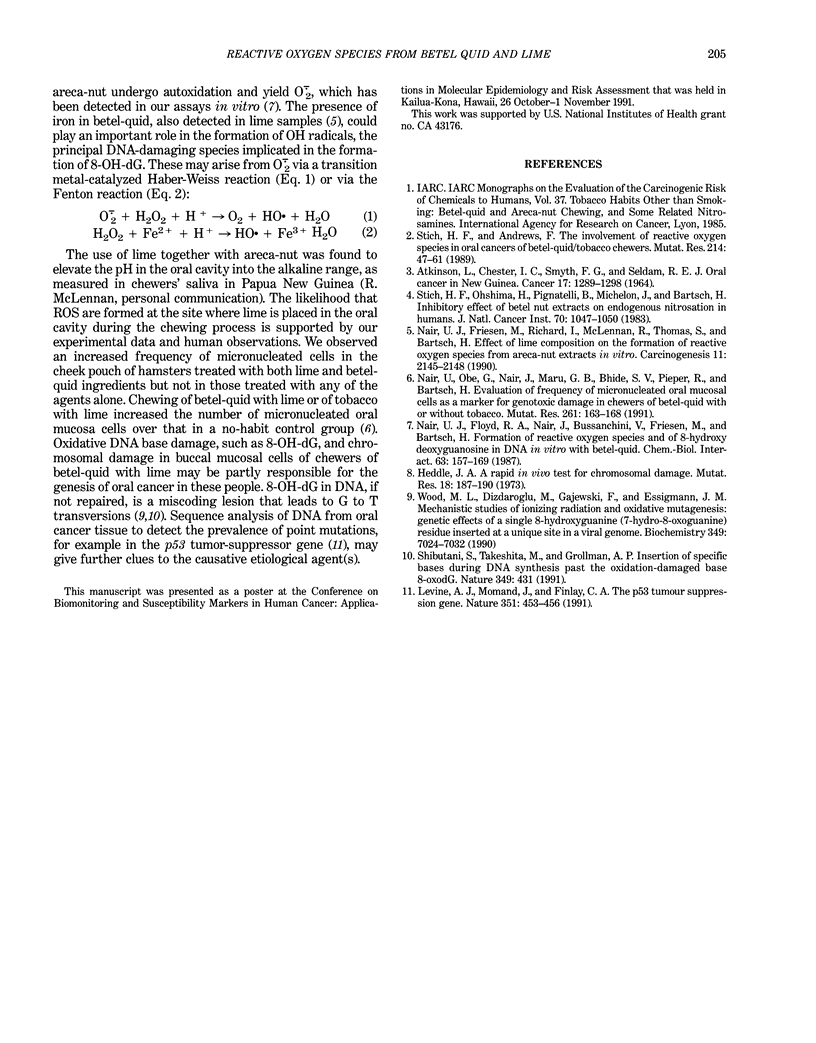Abstract
The role of lime in the formation of reactive oxygen species (ROS), i.e., O2-., H2O2, and OH., from betel-quid components (extracts of areca nut and catechu) was investigated in vitro using a chemiluminescence technique and an assay for oxidative DNA damage involving analysis of 8-hydroxy-2'-deoxyguanosine. Of the various areca-nut extracts, the catechin fraction, at alkaline pH, was shown to be the most active producer of ROS. The free Ca(OH)2 content and pH of lime samples (a component of betel quid and chewing tobacco) were highly correlated with the generation of ROS from areca-nut extract in vitro and with oxidative base damage to DNA in vitro. While Fe2+ had an enhancing effect on ROS formation, Mg2+ had a marked inhibitory effect. The cytogenetic effects of ROS generated in vivo were measured in Syrian golden hamsters in which the cheek pouch had been painted with lime and an areca-nut extract or catechu, singly or in combination. The frequency of micronucleated cells was increased only in animals that had received both the areca-nut extract and lime. The frequency of micronucleated cells in exfoliated oral mucosal cells from Indian chewers of betel quid with tobacco containing lime or of tobacco with lime was significantly higher than in a control (no habit) group. These studies demonstrate that addition of lime to betel quid constituents generates ROS, which induce cytogenetic damage in hamster cheek pouch and may contribute to the cytogenetic damage observed in the oral cavity of betel-quid chewers. These results implicate ROS in clastogenesis and probably in the etiology of oral cancer.
Full text
PDF


Selected References
These references are in PubMed. This may not be the complete list of references from this article.
- ATKINSON L., CHESTER I. C., SMYTH F. G., TEN SELDAMR ORAL CANCER IN NEW GUINEA. A STUDY IN DEMOGRAPHY AND ETIOLOGY. Cancer. 1964 Oct;17:1289–1298. doi: 10.1002/1097-0142(196410)17:10<1289::aid-cncr2820171011>3.0.co;2-e. [DOI] [PubMed] [Google Scholar]
- Heddle J. A. A rapid in vivo test for chromosomal damage. Mutat Res. 1973 May;18(2):187–190. doi: 10.1016/0027-5107(73)90035-3. [DOI] [PubMed] [Google Scholar]
- Levine A. J., Momand J., Finlay C. A. The p53 tumour suppressor gene. Nature. 1991 Jun 6;351(6326):453–456. doi: 10.1038/351453a0. [DOI] [PubMed] [Google Scholar]
- Nair U. J., Floyd R. A., Nair J., Bussachini V., Friesen M., Bartsch H. Formation of reactive oxygen species and of 8-hydroxydeoxyguanosine in DNA in vitro with betel quid ingredients. Chem Biol Interact. 1987;63(2):157–169. doi: 10.1016/0009-2797(87)90095-0. [DOI] [PubMed] [Google Scholar]
- Nair U. J., Friesen M., Richard I., MacLennan R., Thomas S., Bartsch H. Effect of lime composition on the formation of reactive oxygen species from areca nut extract in vitro. Carcinogenesis. 1990 Dec;11(12):2145–2148. doi: 10.1093/carcin/11.12.2145. [DOI] [PubMed] [Google Scholar]
- Nair U., Obe G., Nair J., Maru G. B., Bhide S. V., Pieper R., Bartsch H. Evaluation of frequency of micronucleated oral mucosa cells as a marker for genotoxic damage in chewers of betel quid with or without tobacco. Mutat Res. 1991 Nov;261(3):163–168. doi: 10.1016/0165-1218(91)90063-r. [DOI] [PubMed] [Google Scholar]
- Shibutani S., Takeshita M., Grollman A. P. Insertion of specific bases during DNA synthesis past the oxidation-damaged base 8-oxodG. Nature. 1991 Jan 31;349(6308):431–434. doi: 10.1038/349431a0. [DOI] [PubMed] [Google Scholar]
- Stich H. F., Anders F. The involvement of reactive oxygen species in oral cancers of betel quid/tobacco chewers. Mutat Res. 1989 Sep;214(1):47–61. doi: 10.1016/0027-5107(89)90197-8. [DOI] [PubMed] [Google Scholar]
- Stich H. F., Ohshima H., Pignatelli B., Michelon J., Bartsch H. Inhibitory effect of betel nut extracts on endogenous nitrosation in humans. J Natl Cancer Inst. 1983 Jun;70(6):1047–1050. [PubMed] [Google Scholar]


